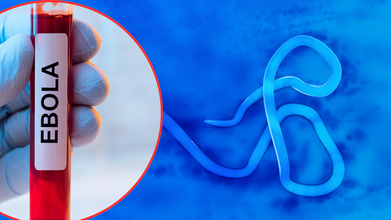- Health Conditions A-Z
- Health & Wellness
- Nutrition
- Fitness
- Health News
- Ayurveda
- Videos
- Medicine A-Z
- Parenting
Congo Ebola Outbreak Caused By The Zaire Strain So Far Has 28 Deaths, Confirms WHO

(Credit- Canva)
The Democratic Republic of Congo (DRC) has officially declared a new Ebola outbreak in its Kasai Province. The virus responsible is the highly dangerous Zaire strain. As per the World Health Organization (WHO), the "virus is believed to have jumped from an animal to a human". The first known case was a 34-year-old pregnant woman who died on August 25, reports WHO. Two healthcare workers who cared for her also became infected and passed away. As of September 15 WHO has confirmed a total of 81 cases and 28 deaths, including four healthcare workers.
How Fatal Is Zaire Strain of Ebola?
According to 1983 The Journal of Infectious Diseases study, this strain of Ebola is different and far more deadly than the Sudan strain which caused an outbreak in Uganda as recently as January 2025.
- In the study, the Zaire strain killed 90% of those infected.
- The Sudan strain was also very dangerous, but less so, killing between 55% and 65% of people.
How Ebola Spreads and Its Symptoms
The WHO explains that the Ebola was first discovered in 1976. Scientists believe it originally comes from fruit bats. From there, it can spread to humans who come into contact with other infected animals, like monkeys. Once a person is infected, the virus spreads to others mainly through direct contact with their blood or other body fluids and is a deadly zoonotic disease (World Organization for Animal Health)
Symptoms can show up anywhere from 2 to 21 days after exposure and often start very suddenly. Early signs include a high fever, extreme tiredness, and muscle pain. As the disease gets worse, it can cause vomiting, diarrhea, and internal or external bleeding. Without fast medical care, the death rate can be as high as 50% to 90%. Ebola can spread quickly in crowded places like hospitals and during funerals, where people might touch the body of someone who died from the virus.
Can Ebola Be Cured?
While there isn't a single cure, there are effective treatments. The Ervebo vaccine is a powerful tool being used to contain the current outbreak. This vaccine is highly effective against the Zaire strain of Ebola—the one in this outbreak—and has a 100% success rate when given right after someone has been exposed.
Also Read: Weatherman Geoff Fox Announces To Enter Hospice Care For The Recurrent Cancer Treatment
Why Is This Ebola Outbreak A Cause of Concern
The Ebola virus has caused a big wave of concern in the country. The DRC is already dealing with other major health crises, like mpox, cholera, and measles, which are stretching its limited resources. The country is also facing armed conflict, making it hard to get medical supplies and staff to remote communities.
Even though the affected area, Kasai Province, is somewhat isolated, it's close to a major city and the border of Angola. This raises the risk that the virus could spread to new areas as people travel for work and trade.
To stop the spread, health officials are using a strategy called "ring vaccination." This means they're vaccinating not only people who are infected but also everyone they've been in contact with, as well as frontline healthcare workers. Other key actions include quickly separating sick people from healthy ones and tracing their contacts. The WHO and its partners have sent 48 experts to the region and provided special medication called Mab114 to treat patients. They are also helping neighboring countries prepare in case the virus crosses borders.
How Was Early Detection Possible For Ebola?
Modern technology is helping to spot outbreaks faster than ever before. An AI platform called EPIWATCH noticed a sharp increase in reports of illness in the DRC in early September, even before the outbreak was officially confirmed. This early warning can give authorities a crucial head start in their response, especially in areas with limited medical testing.
The WHO believes that if the outbreak is contained quickly, its impact will likely stay local. The risk is currently assessed as high for the DRC, moderate for the surrounding region, and low globally.
2 Dead, 21 Injured After Pennsylvania Nursing Home Catches Fire

Source: Parkland Fire Company
A Pennsylvania nursing home caught on fire due to an apparent gas explosion. The Silver Lake Nursing home in Pennsylvania's Bristol Township caught on fire, and videos show flames erupting from the building, and debris scattered around the area. The Pennsylvania Governor Josh Shapiro confirmed the that there are so far two deaths, with 21 people found injured. Many have been rescued, yet rescuers believe that five people are unaccounted for.
What Happened At The Silver Lake Nursing Home?
At 2.15pm is when the flames could be seen from the gas-related explosion. PECO confirmed that crew had started to respond around 2pm itself after they received reports of a gas odor. The explosion had occurred when the crew were on the scene.
“While crews were on site, an explosion occurred at the facility. PECO crews shut off natural gas and electric service to the facility to ensure the safety of first responders and local residents,” the utility said in a the statement.
State Rep. Tina Davis told the Associated Press. "I saw smoke and I saw car after car after car was a fire truck or ambulance from all over the city, from all over."
Davis says that there were talks of using a nearby school as a temporary evacuation area.
How Are Burn Injuries Treated?
Burn injuries are first classified before the treatment. Their classification decides the treatment the burn will require. There are for classifications of burns:
First-degree or superficial burns: They only affect the outer layer of the skin or the epidermis. In these injuries, the burn site is red, painful, dry, and has no blisters.
Second-degree or partial thickness burns: They are only the burns of epidermis and part of the lower layer of the skin, the dermis. The burn site looks red and blistered and may be swollen and painful.
Third-degree or full thickness burns: Third-degree burns destroy the epidermis and dermis. They could also go to the innermost later of the skin, the subcutaneous tissue. The burn site could look white or blackened and charred.
Fourth-degree burns: They burn through both layers of the skin and underlying tissue as well as deeper tissue, and could possibly reach muscle and bone. There is no feeling in the area since the nerve endings are destroyed.
The right way to treat a burn depends on its depth and how much of the body it covers. While minor, superficial burns can be managed at home, deeper or larger burns may need medical attention. Keep these essential guidelines in mind:
Do's:
- Remove the source of the burn immediately – For example, take off clothing soaked in hot liquid to prevent further damage.
- Run cool water over the burn – This helps soothe the skin, except in cases of certain chemical burns.
- Keep the burn clean and protected – Cover it with a clean, non-stick bandage when possible.
- Seek medical help – If the burn is deeper than a superficial layer, larger than your hand, or full-thickness, see a doctor.
Don’ts:
- Use home remedies like bleach or butter – These can make the burn worse.
- Apply ointments or creams on deep burns – They can trap heat and worsen the injury.
- Put ice on the burn – It can cause more damage to the skin.
- Pop blisters – This increases the risk of infection.
Ben Sasse Diagnosed With Stage 4 Pancreatic Cancer: What We Know About His Diagnosis

Credits: Canva/AP
Former Senator Ben Sasse shared on Tuesday that he has been diagnosed with Stage 4 pancreatic cancer. The former two-term senator, now 53, revealed in a long social media message that he learned about the illness last week. “This is a hard note to write, but since many of you have already sensed something, I’ll get straight to it: Last week I was diagnosed with metastasized, stage-four pancreatic cancer, and I am going to die,” Sasse wrote. He went on to describe advanced pancreatic cancer as “brutal” and called it a death sentence, adding that mortality is something everyone carries.
“I’m fortunate to have incredible siblings and half a dozen friends who are truly like brothers to me. As one of them said, ‘Yes, you’re on the clock, but all of us are.’ Death is a cruel thief, and none of us escape it,” he added.
The Nebraska Republican also wrote, “I’ll have more to share. I’m not giving up without a fight.”
Ben Sasse Diagnosed With Stage 4 Cancer
Former senator and former University of Florida president Ben Sasse announced on Tuesday, Dec. 23, that he has been diagnosed with terminal stage 4 cancer, as per CNN News.
In the deeply personal message, the former Republican lawmaker from Nebraska described the diagnosis as a “death sentence,” while expressing appreciation for the steady support of his family and close friends.
Ben Sasse: What Happens In Stage 4 Pancreatic Cancer?
Stage 4 pancreatic cancer, also known as metastatic pancreatic cancer, means the disease has spread beyond the pancreas to distant organs such as the liver, lungs, or the lining of the abdomen. At this advanced stage, the cancer is generally considered incurable, and care focuses on prolonging life and easing symptoms like pain, weight loss, and jaundice through palliative treatment, with the goal of preserving quality of life, as per Cleveland Clinic.
Stage 4 Pancreatic Cancer: How Do Pancreatic And Prostate Cancer Survival Rates Compare?
Pancreatic cancer has a far poorer survival outlook than prostate cancer, largely because it is usually detected late and has fewer effective treatment options. Most men diagnosed with prostate cancer that has not spread survive at least five years, while pancreatic cancer is often found at an advanced stage, where long-term survival is uncommon.
According to the American Cancer Society, pancreatic cancer makes up about 3 percent of all cancers in the United States but accounts for roughly 8 percent of cancer-related deaths. Most patients are diagnosed at Stage 4, and the disease is widely regarded as largely incurable. Prostate cancer, by contrast, is the second most common cancer among men, and the majority of those diagnosed do not die from it. The five-year relative survival rate for non-metastasized prostate cancer is 97.9 percent, dropping to about 38 percent once it spreads. These figures highlight how early detection and effective treatment options make prostate cancer far more survivable than pancreatic cancer.
Recent news has included diagnoses such as Ben Sasse’s terminal pancreatic cancer, as well as public figures like John Eimen, who died from prostate cancer. These cases draw attention to the difficulty of detecting pancreatic cancer early, since there are few reliable screening tools before symptoms appear. Prostate cancer, in contrast, often progresses slowly, and with regular screening and multiple treatment options, many men live for decades after diagnosis.
Ben Sasse: What Treatment Options Is Ben Sasse Pursuing For Stage-Four Pancreatic Cancer?
While treatments including chemotherapy, radiation, and in rare situations surgery are available, stage-four pancreatic cancer is still considered largely incurable. The absence of effective early screening contributes to delayed diagnosis, and although a small number of patients, such as Ruth Bader Ginsburg, have lived longer following surgery, these cases are rare. Well-known individuals including Alex Trebek and Aretha Franklin also battled the disease, which remains one of the deadliest cancers in the United States.
National Obesity Registry Launched To Address India’s Rising Obesity Crisis, Says Dr Jitendra Singh

Credits: Canva
Union Minister of State (Independent Charge) for Science and Technology and Earth Sciences, along with responsibilities in the PMO, Personnel, Public Grievances, Pensions, Atomic Energy, and Space, Dr Jitendra Singh on Tuesday called for careful and evidence-led use of anti-obesity and weight-reduction medicines. He stressed that these drugs should be prescribed thoughtfully and not treated as routine or easy solutions.
Addressing the inaugural session of the Asia Oceania Conference on Obesity (AOCO), the minister said obesity is a complex, long-term condition that tends to recur and cannot be managed through isolated medical treatment alone. Instead, he said, it needs a wider response involving society at large.
At the same event, Dr Singh also launched the National Obesity Registry, describing it as an important step towards strengthening India’s obesity research framework. The initiative aims to support structured data collection, generate reliable evidence, and guide long-term policymaking in the area.
What Is National Obesity Registry?
During the conference, Dr Jitendra Singh formally unveiled the AIAARO Obesity Registry, calling it a major move to strengthen India’s research ecosystem. The registry will focus on systematic data collection, long-term follow-up, and evidence-based policymaking. It is expected to help improve clinical understanding of obesity and support the development of national strategies for its management.
India’s National Obesity Registry (NOR), launched in December 2025, is designed to create a strong and reliable data base on obesity trends across the country. This data will support public health policies, research efforts, and targeted interventions to address the growing obesity burden. The initiative is particularly significant for India, given its unique challenges related to metabolic obesity and its strong links with non-communicable diseases.
While launching the registry, Dr Singh also highlighted the strong focus placed by Prime Minister Narendra Modi on tackling lifestyle-related illnesses. He noted that the Prime Minister has repeatedly spoken about obesity on national platforms, reflecting a clear shift towards preventive healthcare. This approach, he said, is supported by initiatives such as FIT India, Khelo India, and programmes that encourage small but lasting behavioural changes.
Obesity Cannot Be Treated with Shortcuts: Dr Jitendra Singh
The minister warned against the increasing commercialisation of obesity treatment and the spread of misinformation in this space. Referring to a PIB release, he said unscientific claims and so-called quick solutions often mislead people and divert attention from treatments backed by medical evidence.
India has seen a growing use of injectable obesity treatments such as Wegovy and Poviztra, both based on semaglutide, and Yurpeak, which uses tirzepatide. These once-weekly injections work by mimicking gut hormones that help regulate appetite and are marketed by companies like Novo Nordisk and Eli Lilly. However, doctors caution that these drugs are not miracle solutions and must be combined with proper diet and physical activity. There are also concerns about their overuse at a time when obesity rates continue to rise.
India And Obesity
According to the World Health Organisation, obesity was linked to 3.7 million deaths globally in 2024. If strong action is not taken, the number of people living with obesity is expected to double by 2030. Recently, the WHO released its first-ever guideline on the use of Glucagon-Like Peptide-1, or GLP-1, therapies for managing obesity as a chronic and relapsing condition.
“Obesity is a major global health challenge that WHO is committed to addressing by supporting countries and people worldwide to control it effectively and equitably. Our new guidance recognises that obesity is a chronic disease that can be treated with comprehensive and lifelong care,” said WHO Director-General Dr Tedros Adhanom Ghebreyesus.
© 2024 Bennett, Coleman & Company Limited

